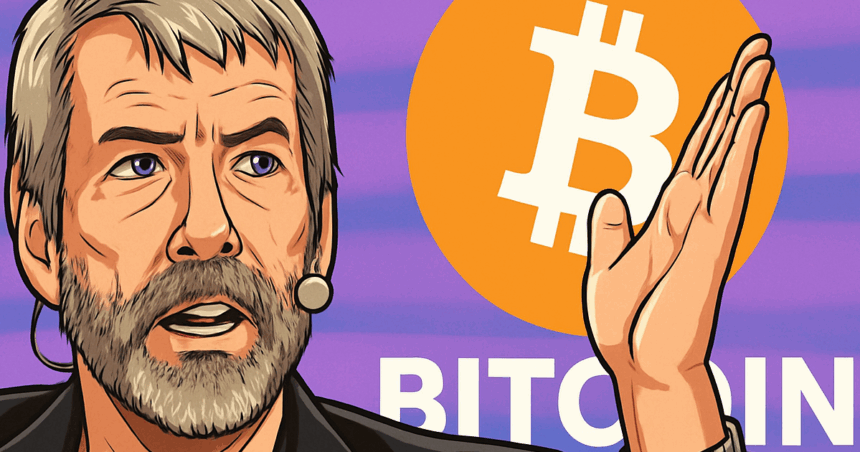The co-founder and executive chairman of Strategy (formerly MicroStrategy) is once again making headlines. This time, it’s not just about another Bitcoin purchase—but a bold, long-term prediction that could shift the way institutions and retail investors think about Bitcoin’s future value.
Highlights:
Institutional Bitcoin Adoption Fuels Saylor’s Optimism
Bitcoin‘s narrative has always been rooted in decentralization and scarcity. But over the past few years, the narrative has evolved. Today, we are witnessing something much larger: a structural shift in how the world’s largest financial players view digital assets. And Michael Saylor is at the forefront of this transition.
During a recent CNBC interview on June 6, Saylor made it clear—he’s “getting more bullish.” What sparked this renewed confidence? It’s not just price movements. It’s the growing belief that Bitcoin has become a legitimate, institutional-grade asset.
He pointed to the increased number of public companies—over 100—that now hold Bitcoin on their balance sheets. Major players in finance, including ETFs, corporations, and even banks, are starting to accumulate Bitcoin as part of their long-term strategies. This isn’t speculation. It’s strategy.
With regulatory clarity finally emerging in the United States, banks are now permitted to offer Bitcoin custody. The digital asset is officially categorized as a commodity. And fair value accounting is being introduced, allowing companies to reflect real-time prices of Bitcoin holdings on their balance sheets. These aren’t minor updates—they’re game-changers that are giving corporate treasurers confidence to act.
Why Saylor Is Revising His Forecast Upward
In July 2024, Saylor released a long-term forecast suggesting Bitcoin could grow by 29% annually, reaching $13 million by the year 2045. At the time, Bitcoin was trading around $65,000. Less than a year later, that prediction is gaining even more credibility.
Bitcoin now trades above $105,000, and Saylor isn’t backing down. In fact, he’s revising his expectations upward, saying he’s “comfortable forecasting 30% a year on average for the next 20 years.”
While some might view this as extreme optimism, Saylor frames it as a data-driven outlook. He believes current trends support even faster growth than initially expected. As the digital asset continues to outperform traditional markets, many investors are starting to realize that Bitcoin’s long-term growth potential might still be underestimated.
Bitcoin Hitting $13 Million by 2045

Saylor’s $13 million target is based on a compound annual growth rate (CAGR) of 30%. At first glance, that figure might seem ambitious. But when placed alongside Bitcoin’s historical performance, it begins to look realistic—perhaps even conservative.
In the last four and a half years, Bitcoin has returned an annualized 57%, according to Saylor. That’s more than twice the return of the so-called “Magnificent Seven” tech stocks, four times the gains of the S&P 500, and eight times what real estate investors have earned. Meanwhile, bond markets have produced negative returns during the same period.
Saylor isn’t claiming that Bitcoin will maintain that exact pace forever. But he believes that even as returns normalize, a 30% annual return remains a rational and achievable target—especially considering the scarcity and rising demand.
If Bitcoin continues to mature as an asset class and institutional adoption continues to accelerate, reaching $13 million by 2045 might not be a fantasy. It could be a financial milestone.
Tight Bitcoin Supply Meets Institutional Demand
Another key reason behind Saylor’s bullish stance is Bitcoin’s limited supply. Unlike fiat currencies, Bitcoin has a capped total supply of 21 million coins. And as of now, the number of new coins entering circulation has slowed dramatically.
Only 450 new Bitcoins are mined each day. At current prices, that’s roughly $45 to $50 million in new daily issuance. This supply is being absorbed almost entirely by institutional buyers—ETFs, public companies, and corporate treasuries.
As Saylor points out, the result is simple economics: when demand rises and supply stays fixed—or shrinks—prices move up. This basic principle is one of the most powerful forces behind his bullish projection.
And there’s something else. The longer Bitcoin’s price stays above $100,000, the more validation it gives to those still on the sidelines. What used to be considered speculative is now beginning to look strategic.
Strategy’s Steady Bitcoin Buy: 8 Weeks in a Row
Saylor’s conviction isn’t just theoretical. It’s backed by action. His company, Strategy, has now purchased Bitcoin for eight consecutive weeks, with the most recent buy occurring between May 26 and June 1. During that time, the company acquired an additional 705 BTC, spending around $75 million at an average price of $106,495 per coin.
But the purchases didn’t stop there.
On June 8, Saylor posted a now-famous phrase on X: “Send more Orange.” To those familiar with his cryptic style, this usually precedes a major announcement—and often, a Bitcoin purchase. If Strategy follows through, it will mark the ninth consecutive week of acquisitions.
With this steady buying pattern, Strategy is signaling more than just belief. It’s communicating a long-term strategy that goes far beyond short-term market timing.
Issuing Preferred Stock to Fund Bitcoin: The STRD Offering Explained
Backing up this aggressive accumulation strategy is an equally bold financial move.
In a recent development, Strategy announced a $1 billion stock offering. Originally planned as a $250 million raise, the offering was expanded fourfold due to investor interest. The company is offering 11.76 million shares of its Series A Perpetual Stride Preferred Stock at $85 per share.
What’s unique here is the type of stock being offered. These preferred shares come with a 10% non-cumulative dividend, targeting institutional investors looking for yield. Unlike common stock, these shares offer more predictable returns, making them attractive to conservative investors—even as the company continues to invest heavily in a volatile asset like Bitcoin.
After underwriting and related expenses, Strategy expects to raise $979 million—most of which will go toward purchasing even more Bitcoin. In short, Strategy is transforming itself into a hybrid model: part enterprise software company, part Bitcoin holding entity.
This strategic transformation has led many investors to view Strategy as a proxy for Bitcoin exposure, especially among those unable to hold Bitcoin directly due to regulations or custodial limits.
Regulatory & Accounting Shifts Reinforce Bitcoin’s Role as Digital Commodity
For years, one of the biggest hurdles to mainstream adoption was regulatory uncertainty. Now, that landscape is finally changing.
U.S. regulators have officially classified Bitcoin as a digital commodity. This distinction is important. It separates Bitcoin from other crypto assets that may be treated as securities, which face tighter restrictions and oversight. As a result, more traditional financial institutions are beginning to feel comfortable entering the space.
Fair value accounting rules have also been adopted, allowing companies to mark Bitcoin at its market value on their balance sheets. This solves a longstanding issue in financial reporting and removes one of the main barriers for corporations considering digital asset exposure.
Finally, new guidance has made it possible for banks to offer Bitcoin custody services. This regulatory green light removes another key obstacle for institutions, many of which are required by law to hold assets with licensed custodians.
Together, these changes amount to a seismic shift. They don’t just make it easier to own Bitcoin—they make it safer, more transparent, and more integrated into the existing financial system.
Final Thoughts: Bitcoin’s Evolution Is Only Just Beginning
Michael Saylor’s $13 million Bitcoin forecast might sound outrageous to the average person. But when viewed through the lens of supply, demand, regulation, and performance history, it becomes more plausible than it seems.
The market has matured. Bitcoin is no longer just a speculative asset—it’s becoming a strategic reserve for corporations, a hedge against inflation, and a long-term investment for institutional players.
Strategy’s recent actions—weekly purchases, a billion-dollar stock raise, and active public messaging—show just how seriously one of the most prominent corporate investors is taking Bitcoin’s future.
Whether or not Bitcoin actually reaches $13 million by 2045 is unknown. But what is clear is this: the infrastructure, demand, and conviction required to push it there are rapidly falling into place.
This isn’t just another wave of crypto hype. It’s the start of a long-term shift. And if Michael Saylor is right, we’re only in the early chapters of Bitcoin’s true story.
Latest Crypto News:
- Billionaire’s Conflict Shake-Up and Wake-Up the Crypto Market
- Bitcoin News: Trump vs Musk, Tesla Crash, Circle IPO
- Bitcoin News: JPMorgan, MoonPay, and K-Wave Drive BTC Adoption
- Why Ethereum Is Attracting More Institutional Capital
- Bitcoin Hits New All-Time High: What’s Next?
- How High Can Bitcoin Go in 2025?
- Ripple to Unlock 1 Billion XRP in June 2025
- Ripple joins Hands With Zand Bank and Mamo
- Is XRP Worth Buying? Can XRP Reach $10?
- Ripple Vs SEC Settlement Rejected
- XRP Price Prediction: Massive XRP Breakout Coming?
- XRP News Today: Ripple About to Shatter All-Time Highs?
- How High Can Bitcoin Go in 2025?
- SUI Token Unlock: SUI Price Prediction After Token Unlock














